Требуется руководство для вашей Zanussi FLS 802 Стиральная машина? Ниже вы можете просмотреть и загрузить бесплатно руководство в формате PDF. Кроме того, приведены часто задаваемые вопросы, рейтинг изделия и отзывы пользователей, что позволит оптимально использовать ваше изделие. Если это не то руководство, которое вы искали, – свяжитесь с нами.
Ваше устройство неисправно, и в руководстве отсутствует решение? Перейдите в Repair Café для получения бесплатных ремонтных услуг.
Руководство

Рейтинг
Сообщите нам, что вы думаете о Zanussi FLS 802 Стиральная машина, оставив оценку продукта. Хотите поделиться вашими впечатлениями от данного изделия или задать вопрос? Вы можете оставить комментарий в нижней части страницы.
Довольны ли вы данным изделием Zanussi?
Да Нет
Будьте первым, кто оценит это изделие
0 голоса
Часто задаваемые вопросы
Наша служба поддержки выполняет поиск полезной информации по изделиям и отвечает на часто задаваемые вопросы. Если вы заметили неточность в наших часто задаваемых вопросах, сообщите нам об этом с помощью нашей контактной формы.
Стиральная машина не реагирует, когда я нажимаю кнопку включения. Что мне делать? Проверенный
Это обычно означает, что дверца стиральной машины недостаточно плотно закрыта. Откройте и закройте дверцу и попробуйте снова.
Это было полезно (21423)
Моя стиральная машина не запускает слив. Что делать? Проверенный
Основной причиной того, что стиральная машина не запускает слив, может быть засор в шланге подачи или слива воды. Если у вас есть доступ к этим шлангам, постарайтесь удалить засорение. Если проблема не решается, или у вас нету доступа к шлангам, обратитесь к специалисту по ремонту машин или к производителю.
Это было полезно (21377)
В стиральную машину не поступает вода, что мне делать? Проверенный
Проверьте, открыт ли входной патрубок для воды и нет ли перегибов в шланге подачи воды. Если это не решит проблему, обратитесь к производителю.
Это было полезно (8282)
Дверца стиральной машины не открывается, что мне делать? Проверенный
Причин может быть несколько. Наиболее частая причина — засорение фильтра. Отключите прибор от сети и проверьте фильтр. При необходимости удалите все засорения. Расположение фильтра зависит от модели. Также возможно наличие специального рычага для открытия двери. Если эти варианты не помогают, последний вариант — отключить прибор от сети на 30-60 минут и после этого попытаться открыть дверцу. Если это не сработает, обратитесь к производителю или механику.
Это было полезно (6627)
Моя стиральная машина громко шумит и/или вибрирует. Что делать? Проверенный
Возможно, вы не выровняли стиральную машину. Это можно сделать, отрегулировав ножки машины. Также причина проблемы может крыться в избыточной загрузке машины. Если причина шума и вибрации не в этом, обратитесь к производителю.
Это было полезно (6004)
В какое отделение должно быть моющее средство? Проверенный
У большинства стиральных машин есть 3 отделения для моющего средства. Эти отделения часто имеют маркировку I, II и *, чтобы показать, куда идет моющее средство. Ячейка I используется для предварительной стирки, II — для основной стирки, а * — для кондиционера. Чаще всего используется второй отсек.
Это было полезно (3913)
Моя стиральная машина пахнет, что мне делать? Проверенный
Есть стиральные машины с функцией самоочистки. Если эти функции недоступны, можно добавить 100 мл белого уксуса или 100 г кристаллов соды и запустить стиральную машину по программе 90 ℃.
Это было полезно (3160)
Могу ли я подключить стиральную машину к розетке с теплой водой? Проверенный
Хотя стиральные машины, вероятно, могут подавать воду до 65 ° C, большинство производителей не рекомендуют это делать. Существуют циклы стирки, в которых используется только холодная вода. В таких случаях теплая вода может повредить результат вашей стирки. Также многие стиральные машины рассчитаны на подключение к розетке холодной воды.
Это было полезно (2729)
На что следует обратить внимание при транспортировке стиральной машины? Проверенный
При транспортировке стиральной машины следует зафиксировать положение барабана. Можно использовать транспортировочный болт, который поставляется в комплекте со стиральной машиной. Он не даст барабану вращаться внтури машины. Также необходимо слить всю воду.
Это было полезно (1264)
Можно ли ставить сушильную и стиральную машину одну на другую? Проверенный
В целом сушильную и стиральную машину возможно поставить прямо одну на другую. Это относится только к моделям с фронтальной загрузкой. Тем не менее для этого рекомендуется использовать крепежные элементы. Это позволит избежать вибрации и падения верхней машины и повреждения нижней машины.
Это было полезно (1006)
В чем разница в использовании стиральной машины с сушилкой и отдельной стиральной машины и сушилки? Проверенный
Самым большим преимуществом стирально-сушильной машины является то, что она занимает меньше места. Однако отдельная сушилка сможет сушить больше, чем стирально-сушильная машина. Стирально-сушильная машина также потребляет относительно больше энергии и требует больше времени.
Это было полезно (979)
Можно ли подключить стиральную машину к удлинителю? Проверенный
Технику, требующую большого количества энергии, например стиральную машину, нельзя подключать ко всем удлинителям. Посмотрите, какова потребляемая мощность стиральной машины, которая указывается в ваттах, и проверьте, может ли удлинитель с этим справиться. Существуют удлинители с более толстыми кабелями, предназначенные для работы с более крупными приборами.
Это было полезно (976)
Где можно найти номер модели стиральной машины Zanussi? Проверенный
Номер модели обычно указан на наклейке на внутренней поверхности люка машины. Он также может быть указан на наклейке со внутренней стороны небольшой дверцы, прикрывающей фильтр.
Это было полезно (169)
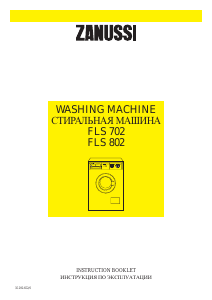
WASHING MACHINE
ЫЕШКФДЦТФÅ ЬФfiШТФ
FLS 702
FLS 802
F L S —
2
3
4
6
7
9
11
13
8
12
5
10
30
°
40
°
50
°
60
°
70
°
80
°
90
°
30º-90º
30º-90º
30º-60º
30º-40º
KOGEVASK MED FORVASK
KOGEVASK UDEN FORVASK
KULØRTVASK
KULØRTVASK
SKYLNINGER
SKYLLEMIDDEL
CENTRIFUGERING
BOMULD OG LINNED
1
2
2
3
4
5
6
SYNTETISK VASK MED FORVASK
SYNTETISK VASK UDEN FORVASK
FINVASK ULD SKYLNINGER
SKILLEMIDDEL
TØMNING
SYNTETISK VASK, FINVASK OG
7
8
9
1
0
1
1
30º-60º
30º-60º
30º-40º
40º
INSTRUCTION BOOKLET
ИНСТРУКЦИЯ ПО ЭКСПЛУАТАЦИИ
35.292.652/0
Посмотреть инструкция для Zanussi FLS 802 бесплатно. Руководство относится к категории стиральные машины, 1 человек(а) дали ему среднюю оценку 7.5. Руководство доступно на следующих языках: английский. У вас есть вопрос о Zanussi FLS 802 или вам нужна помощь? Задайте свой вопрос здесь
Не можете найти ответ на свой вопрос в руководстве? Вы можете найти ответ на свой вопрос ниже, в разделе часто задаваемых вопросов о Zanussi FLS 802.
При какой температуре следует стирать одежду?
Стоит ли использовать средство для удаления накипи при стирке в стиральной машине?
Как предотвратить появление неприятного запаха в стиральной машине?
Инструкция Zanussi FLS 802 доступно в русский?
Не нашли свой вопрос? Задайте свой вопрос здесь
Important Safety Information
It is most important that this instruction book should be retained with the appliance for future reference.
Should the appliance be sold or transferred to another owner, or should you move house and leave the
appliance, always ensure that the book is supplied with the appliance in order that the new owner can get to
know the functioning of the appliance and the relevant warnings.
These warnings have been provided in the interest of safety. You MUST read them carefully before installing or
using the appliance.
CHECK THE APPLIANCE UPON RECEPTION AND SHOULD ANY DAMAGE BE OBSERVED CALL YOUR
RETAILER BEFORE YOU MAKE IT WORK.
Installat ion
Use
■ This appliance is heavy. Care should be taken when
■
Always unplug the appliance and turn off the water
moving it.
after use.
■
■
Do not overload the appliance. See relevant section in
It is dangerous to alter the specifications or attempt to
instruction book.
modify this product in any way.
■
Always look through the glass door to check if water
■
All packing and transit bolts must be removed before
has drained before opening the door before draining
use. Serious damage can occur to the product and to
the water. If in doubt, refer to your instruction book
property if this is not adhered to. See relevant section in
■
The user should always check that they have not left
instructions.
their gas lighter (disposable or otherwise) in their
■
Any plumbing work required to install this appliance
clothing
should be carried out by a qualified plumber or
■
Only wash fabrics which are designed to be machine
competent person.
washed. If in doubt, consult the care label on the
■
Any electrical work required to install this appliance
clothes.
should be carried out by a qualified electrician or
■
Before washing, ensure that all pockets are empty
competent person.
and buttons and zips are fastened. Avoid washing
frayed or torn articles and treat stains such as paint,
■
Care must be taken to ensure that the appliance does not
ink, rust, and grass before washing. Underwired bras
stand on the electrical supply cable.
must NOT be machine washed.
■
If the machine is situated on a carpeted floor, please
■
Any objects such as coins, safety pins, nails, screws,
adjust the feet in order to allow air to circulate freely.
stones or any other hard, sharp material can cause
■
The washing machine must be unplugged when
extensive damage and must not be placed into the
machine.
removing the interior transits bolts. Do not plug the
■
appliance before finishing the removal of the transit
Garments which have been in contact with volatile
bolts and the fixing of the caps in the holes where the
petroleum products should not be machine washed. If
volatile cleaning fluids are used, care should be taken
security bolts were
to ensure that the fluid is removed from the garment
before placing in the machine.
■
Child Safet y
Wash small items such as socks, laces, washable belts
etc in a washing bag or pillow case as it is possible
■
This appliance is designed to be operated by adults.
for such items to slip down between the tub and the
Children should not be allowed to tamper with the
inner drum.
controls or play with the product.
■
Only use the advised quantities of fabric softener.
■
Pets and children have been known to climb into
Damage to the fabric can ensue if you over-fill. Refer
washing machines. Please check your drum before use.
to the manufacturer’s recommendations of quantities.
■
■
As some duvets and eiderdowns should be washed in
The glass door becomes very hot during the washing
large commercial machines because of their bulk,
cycle. Keep children away from the vicinity of the
please check with the manufacturer of the item before
appliance whilst it is in operation.
washing in a domestic machine.
■
Keep all packaging well away for children.
■
Leave the porthole door slightly ajar between washes
■
Keep all detergents in a safe place out of children’s
to preserve the door seal.
reach.
■
Under no circumstances should you attempt to repair
the machine yourself. Repairs carried out by
inexperienced persons may cause injury or serious
malfunctioning. Contact your local Zanussi Service
Centre. Always insist on genuine Zanussi spare parts.
2
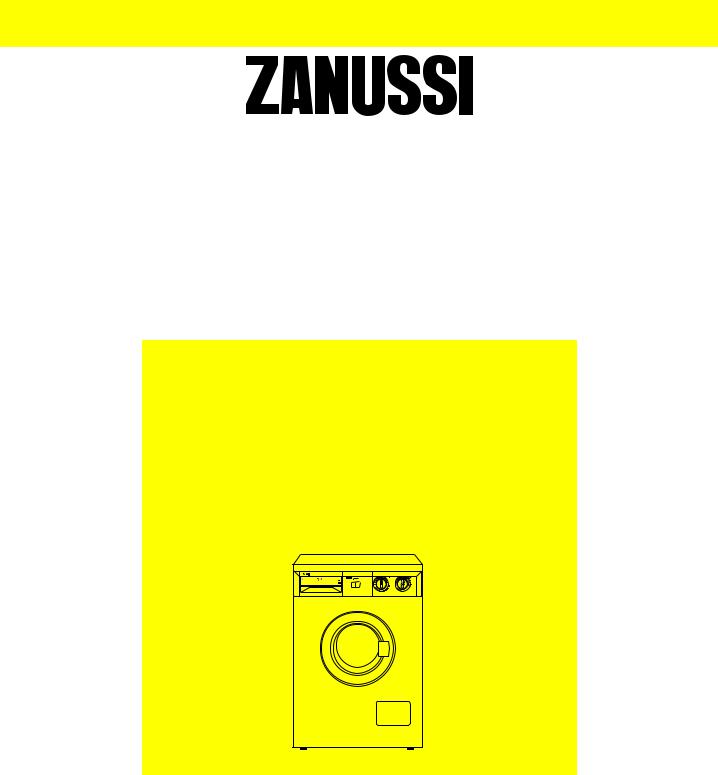
WASHING MACHINE
STIRALWNAÅ MAfiINA
FLS 702
FLS 802
|
°30 |
12 |
|
|
11 |
||
|
°40°50 |
5 |
|
|
6 |
7 |
INSTRUCTION BOOKLET
азлнкмдсаь ий щдлигмАнАсаа
35.292.652/0


It is most important that this instruction book should be retained with the appliance for future reference. Should the appliance be sold or transferred to another owner, or should you move house and leave the appliance, always ensure that the book is supplied with the appliance in order that the new owner can get to know the functioning of the appliance and the relevant warnings.
These warnings have been provided in the interest of safety. You MUST read them carefully before installing or using the appliance.
CHECK THE APPLIANCE UPON RECEPTION AND SHOULD ANY DAMAGE BE OBSERVED CALL YOUR RETAILER BEFORE YOU MAKE IT WORK.
Installation
■This appliance is heavy. Care should be taken when moving it.
■It is dangerous to alter the specifications or attempt to modify this product in any way.
■All packing and transit bolts must be removed before use. Serious damage can occur to the product and to property if this is not adhered to. See relevant section in instructions.
■Any plumbing work required to install this appliance should be carried out by a qualified plumber or competent person.
■Any electrical work required to install this appliance should be carried out by a qualified electrician or competent person.
■Care must be taken to ensure that the appliance does not stand on the electrical supply cable.
■If the machine is situated on a carpeted floor, please adjust the feet in order to allow air to circulate freely.
■The washing machine must be unplugged when removing the interior transits bolts. Do not plug the appliance before finishing the removal of the transit bolts and the fixing of the caps in the holes where the security bolts were
Child Safety
■This appliance is designed to be operated by adults. Children should not be allowed to tamper with the controls or play with the product.
■Pets and children have been known to climb into washing machines. Please check your drum before use.
■The glass door becomes very hot during the washing cycle. Keep children away from the vicinity of the appliance whilst it is in operation.
■Keep all packaging well away for children.
■Keep all detergents in a safe place out of children’s reach.
Use
■Always unplug the appliance and turn off the water after use.
■Do not overload the appliance. See relevant section in instruction book.
■Always look through the glass door to check if water has drained before opening the door before draining the water. If in doubt, refer to your instruction book
■The user should always check that they have not left their gas lighter (disposable or otherwise) in their clothing
■Only wash fabrics which are designed to be machine washed. If in doubt, consult the care label on the clothes.
■Before washing, ensure that all pockets are empty and buttons and zips are fastened. Avoid washing frayed or torn articles and treat stains such as paint, ink, rust, and grass before washing. Underwired bras must NOT be machine washed.
■Any objects such as coins, safety pins, nails, screws, stones or any other hard, sharp material can cause extensive damage and must not be placed into the machine.
■Garments which have been in contact with volatile petroleum products should not be machine washed. If volatile cleaning fluids are used, care should be taken to ensure that the fluid is removed from the garment before placing in the machine.
■Wash small items such as socks, laces, washable belts etc in a washing bag or pillow case as it is possible for such items to slip down between the tub and the inner drum.
■Only use the advised quantities of fabric softener. Damage to the fabric can ensue if you over-fill. Refer to the manufacturer’s recommendations of quantities.
■As some duvets and eiderdowns should be washed in large commercial machines because of their bulk, please check with the manufacturer of the item before washing in a domestic machine.
■Leave the porthole door slightly ajar between washes to preserve the door seal.
■Under no circumstances should you attempt to repair the machine yourself. Repairs carried out by inexperienced persons may cause injury or serious malfunctioning. Contact your local Zanussi Service Centre. Always insist on genuine Zanussi spare parts.
2

Table of Contents
For the User
|
Important Safety Information |
2 |
|
Description of the Appliance |
4 |
|
The Control Panel |
5 |
|
Operating sequence |
6-7 |
|
Before the first use |
6 |
|
Load the laundry |
6 |
|
Measure out the detergent |
6 |
|
Measure out the additives |
6 |
|
Select the temperature |
7 |
|
Select the required programme |
7 |
|
Start the machine |
7 |
|
At the end of the programme |
7 |
|
Washing Programmes |
8-9 |
|
Washing Hints |
10-11 |
|
International wash code symbols |
12 |
|
Maintenance |
13-14 |
|
Bodywork |
13 |
|
Detergent dispenser drawer |
13 |
|
Water inlet filter |
13 |
|
Drain filter |
14 |
|
Emergency emptying out |
14 |
|
The dangers of freezing |
14 |
|
Something Not Working |
15 |
For the Installer
Installation Instructions Technical Specifications Installation
Unpacking Water inlet Water drainage Levelling
Special conditions Electrical connections Permanent connection
16
17
17
18
18-19
19
19
20
20
Guide to use the Instruction Book
The following symbols will be found in the text to guide you throughout the instructions:

How do we help to protect the environment?
We use recycled paper!
3
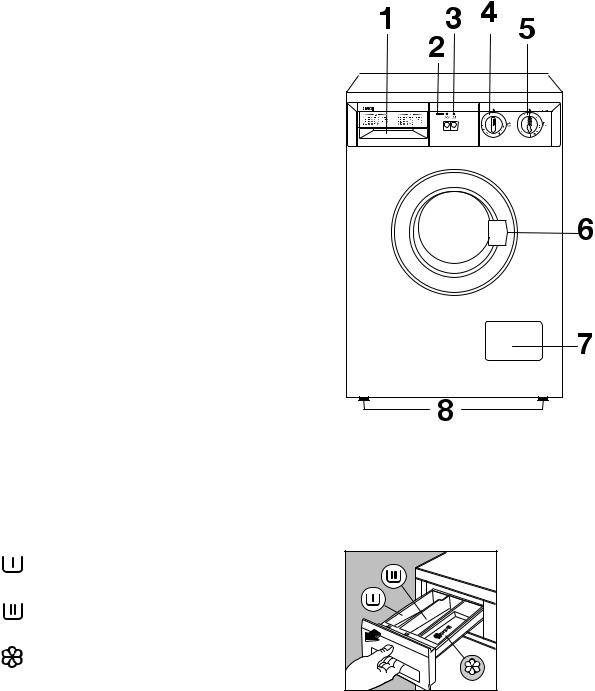
Description of the Appliance
1 Detergent dispenser drawer
2“Mains-on” light
3“Options” buttons
4 Temperature selector dial
5 Program selector dial & ON/OFF switch
6Door opening handle
7Filter
8Adjustable feet
Detergent dispenser drawer
<<prewash>> symbol shows the compartment for the prewash detergent.
<<wash>> symbol shows the compartment for the washing detergent.
<<smooth>> symbol shows the compartment the smoothing additives.
4
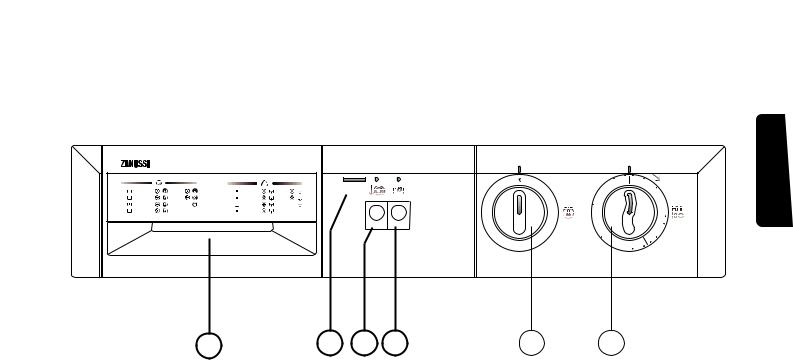
The Control Panel
FLS
|
2 |
1 |
13 |
12 |
|||||||||||
|
2 |
40º60º |
4 |
8 |
40º60º |
1 |
11 |
||||||||
|
3 |
30º40º |
5 |
9 |
30º40º |
1 |
|||||||||
|
1 |
60º90º |
6 |
7 |
40º60º |
1 |
3 |
||||||||
|
2 |
60º90º |
10 |
30º40º |
° |
90 |
10 |
||||||||
|
9 |
||||||||||||||
|
° |
||||||||||||||
|
30 |
80 |
|||||||||||||
|
° |
||||||||||||||
|
70 |
° |
4 |
7 |
8 |
||||||||||
|
40 |
6 |
|||||||||||||
|
°50 |
60 |
° |
5 |
|||||||||||
|
° |
|
1 |
2 |
3 |
4 |
5 |
6 |
1 Programme Guide
2 ON/OFF LAMP
It lights when the appliance is operating.
3 REDUCED SPIN BUTTON
Pressing this button the spinning speed is reduced from 700 to 400 rpm (model FLS 702) and from 800 to 400 rpm (model FLS 802).
4 Half load button
Pressing this button before starting the intense program there will be one rinse less which leads to energy and water saving.
5 TEMPERATURE SELECTOR
This control allows you to select the temperature of the washing cycle in accordance with the kind of clothes to be washed.
To select the required temperature turn the control until the marker on the top coincides with the required temperature (reference mark on the control panel).
On the program chart you will find the most appropriate temperature for each kind of washing.
6 PROGRAM SELECTOR
To select the required program turn the control clockwise until the marker on the top coincides with the number of the required program (reference mark on the control panel). If at any chance you pass by the required number NEVER TURN THE CONTROL ANTICLOCKWISE just continue clockwise until the required number is reached again.
ENGLISH
5

Operating Sequence
i Before your first wash, we recommend that you run a cotton cycle at 60°C, without any laundry in the machine, to remove any manufacturing residue from the drum and tub.
Pour 1/2 a measure of detergent into the dispenser drawer and start the machine.
1. Load the laundry
Open the door.
Place the laundry in the drum, one item at a time, shaking them out as much as possible.
Close the door.
Do not overload the washing machine, but always try to use it utmost capacity in accordance with the type of fabric. Reduce the quantity when washing very dirty or fluffy laundry.
2. Measure out the detergent
Pull out the dispenser drawer until it stops.
Measure out the amount of detergent recommended by the manufacturer in a graduated cup and pour it into the main wash compartment 
If you wish to carry out a prewash (*), pour detergent into the appropriate compartment marked 
(*) Prewash is available in programme “1” .
3. Measure out the additive
If you wish to use additives enter the softener in the compartment with the symbol 
Never exceed the MAX level
4. Select the required option(s)
6
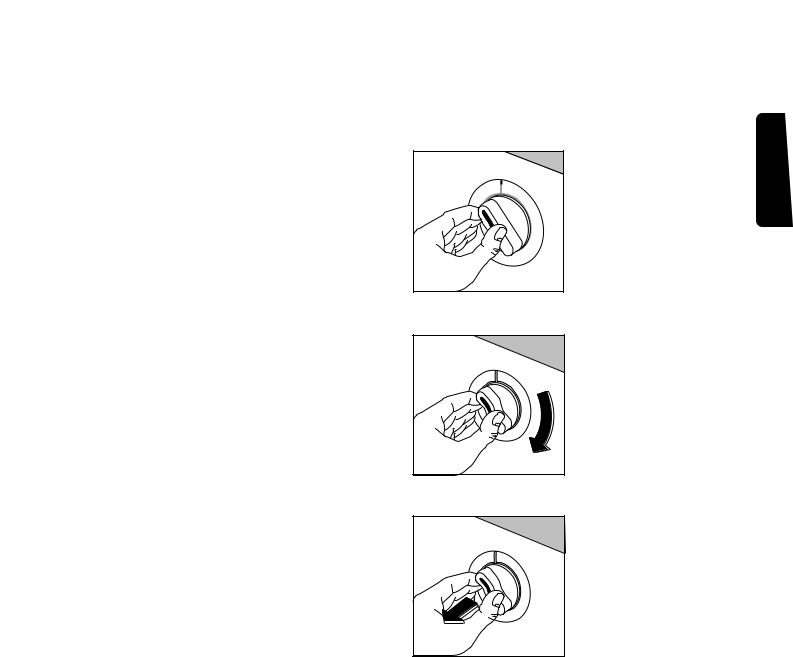
5. Select the temperature
Turn the dial to the desired temperature.
6. Select the required programme
Turn the programme selector dial CLOCKWISE to the required programme.
7. Start the machine
Before starting up the machine check that:
■the appliance is plugged in
■the water supply tap is turned on
■the door and the detergent dispenser drawer are closed.
Pull the programme selector selector dial outwards, the operating pilot light will illuminate and the machine will start operating.
8. At the end of the programme
The machine stops automatically and the operating pilot light goes out.
The door is controlled by a safety device which releases 3 minutes after the end of the programme.
Before opening the door ensure there is no water in the drum.
Switch the machine off by depressing the programme selector dial.
When the programme has finished, you are advised to unplug the appliance and turn off the water tap.
Leave the door open to prevent the formation of mildew and unpleasant smells.
ENGLISH
7
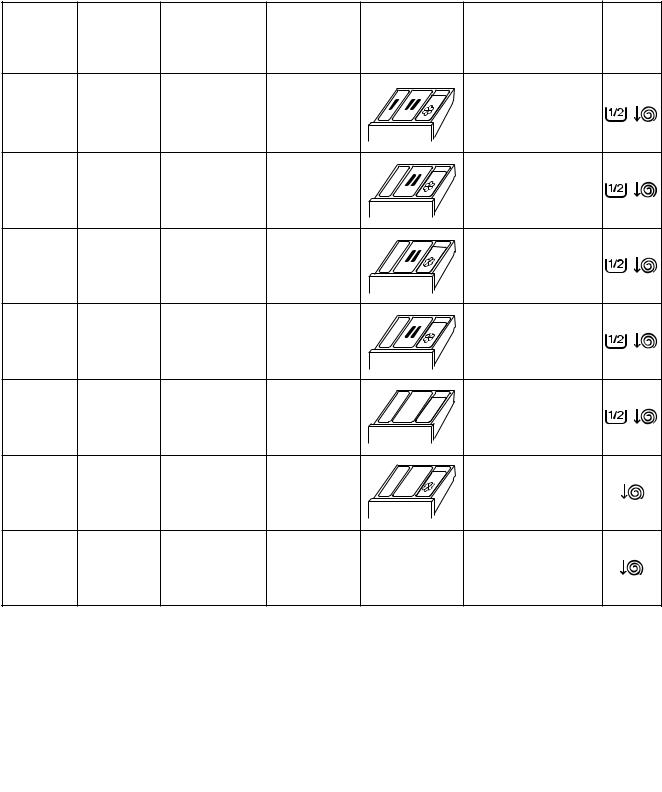
Washing Programmes
Programmes for cotton and linen
Maximum load 4.5 kg
|
Program |
Compartments |
Possible |
|||||
|
dial |
Program |
Temperature ˚C |
Degree of soil |
Description |
|||
|
to use |
options |
||||||
|
position |
|||||||
|
Prewash at 40 ˚C |
|||||||
|
1 |
Whites with |
60°- 90° |
Heavy soiled |
Wash at 60˚- 90˚C |
|||
|
4 rinses |
|||||||
|
prewash |
|||||||
|
Spin at 700 rpm (FLS702) |
|||||||
|
Spin at 800 rpm (FLS802) |
|||||||
|
Whites |
Wash at 60˚- 90˚C |
||||||
|
2 (•) |
60°- 90° |
4 rinses |
|||||
|
without |
Normal soiled |
||||||
|
Spin at 700 rpm (FLS702) |
|||||||
|
prewash |
|||||||
|
Spin at 800 rpm (FLS802) |
|||||||
|
Fast |
Wash at 40˚- 60˚C |
||||||
|
2 |
40°- 60° |
Normal soiled |
4 rinses |
||||
|
Coloureds |
Spin at 700 rpm (FLS702) |
||||||
|
Spin at 800 rpm (FLS802) |
|||||||
|
Non Fast |
Wash at 30˚- 40˚C |
||||||
|
3 |
30°- 40° |
Normal soiled |
4 rinses |
||||
|
Coloureds |
Spin at 700 rpm (FLS702) |
||||||
|
Spin at 800 rpm (FLS802) |
4 rinses
4 Rinses 
|
Additives |
Load additive |
||
|
5 |
1 rinse |
||
|
softener |
Spin at 700 rpm (FLS702) |
||
|
Spin at 800 rpm (FLS802) |
Draining of water
6 Spin Spin at 700 rpm (FLS702) Spin at 800 rpm (FLS802)
(•) This 60°C programme is the reference programme for the Energy label according to EEC Directive 92/75. (Load 4,5 Kg.)
|
FLS 702 |
FLS 802 |
|
|
Water |
72 litres |
72 litres |
|
Energy |
1,17 kWh |
1,17 kWh |
|
Time |
135 minutes |
135 minutes |
8
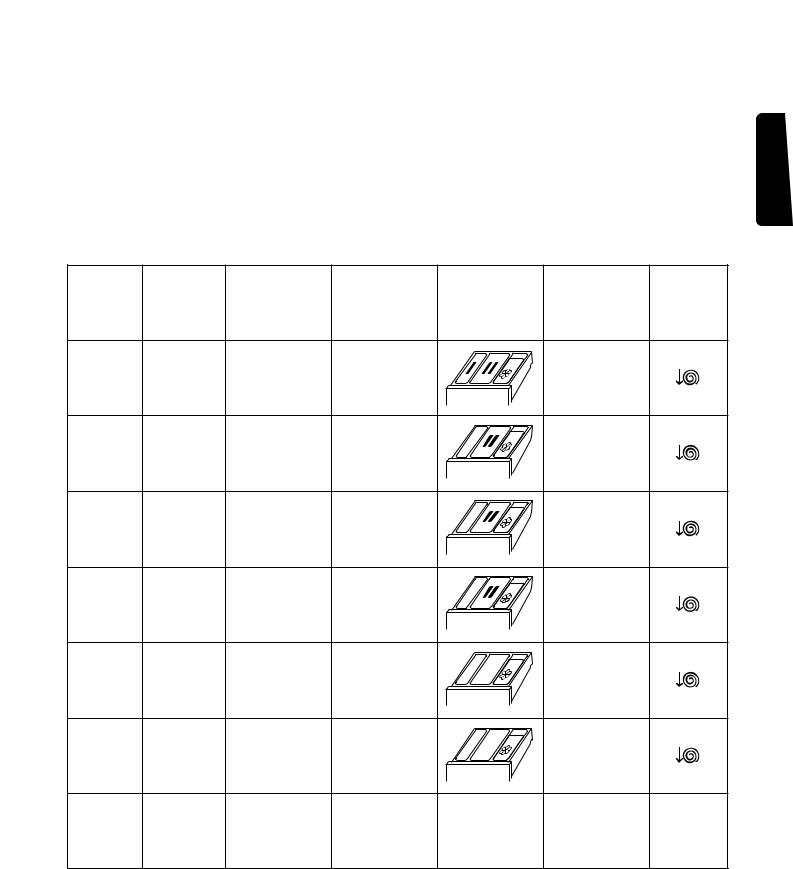
Washing Programmes
Programmes for synthetics, delicates and wool
Maximum load 2 kg (wool maximum load 1 kg)
|
Program |
Compartments |
Possible |
|||||
|
dial |
Program |
Temperature ˚C |
Degree of soil |
Description |
|||
|
to use |
options |
||||||
|
position |
|||||||
|
Mixed |
Prewash at 40 ˚C |
||||||
|
7 |
40°- 60° |
Heavy soiled |
Wash at 40˚- 60˚C |
||||
|
Fabrics |
3 rinses |
||||||
|
Stop with water * |
|||||||
|
8 |
Non Fast |
40°- 60° |
Wash at 40˚- 60˚C |
||||
|
Normal soiled |
3 rinses |
||||||
|
Coloureds |
|||||||
|
Stop with water * |
|||||||
|
9 |
Synthetics |
30°- 40° |
Wash at 30˚- 40˚C |
||||
|
Normal soiled |
3 rinses |
||||||
|
Delicates |
|||||||
|
Stop with water * |
|||||||
|
10 |
Wool Silk |
30°- 40° |
Wash at 30˚- 40˚C |
||||
|
Normal soiled |
3 rinses |
||||||
|
Stop with water * |
|||||||
|
11 |
Rinses |
3 rinses |
|||||
|
Delicates |
Stop with water * |
||||||
|
12 |
Additives |
Load additive |
|||||
|
1 rinse |
|||||||
|
Softener |
|||||||
|
Stop with water * |
|||||||
|
13 |
Drain |
Draining of water |
*The machine will stop after the last rinse with water in the drum. Select either Drain (13) or Spin (6) before attempting to open the door.
ENGLISH
9

i Washing Hints
Sorting the laundry
Follow the wash code symbols on each garment label and the manufacturer’s washing instructions.
Sort the laundry as follows:
whites, coloureds, synthetics, delicates, woollens.
Temperatures
|
95° |
for normally soiled white cottons and linen |
|
(e.g. tea cloths, towels, tablecloths, |
|
|
sheets…). |
|
|
60° |
for normally soiled, colour fast garments |
|
(e.g. shirts, night dresses, pyjamas….) in |
|
|
linen, cotton or synthetic fibres and for |
|
|
lightly soiled white cotton (e.g. |
|
|
underwear). |
|
|
(cold) |
for delicate items (e.g. net curtains), mixed |
|
30°-40° |
laundry including synthetic fibres and |
|
woollens bearing the label «pure new |
wool, machine washable, non-shrink» .
Before loading the laundry
Never wash whites and coloureds together. Whites may lose their “whiteness” in the wash.
New coloured items may run in the first wash; they should therefore be washed separately the first time.
Make sure that no metal objects are left in the laundry (e.g. hair clips, safety pins, pins).
Button up pillowcases, close zip fasteners, hooks and poppers. Tie any belts or long tapes.
Remove persistent stains before washing. Rub particularly soiled areas with a special detergent or detergent paste.
Treat curtains with special care. Remove hooks or tie them up in a bag or net.
Maximum loads
Recommended loads are indicated in the programme charts.
General rules:
Cotton, linen: drum full but not too tightly packed.
Synthetics: drum no more than half full.
Delicate fabrics and woollens: drum no more than one third full.
Washing a maximum load makes the most efficient use of water and energy.
For heavily soiled laundry, reduce the load size.
Laundry weights
The following weights are indicative:
|
Bathrobe |
1200 g |
|
Napkin |
100 g |
|
Quilt cover |
700 g |
|
Sheet |
500 g |
|
Pillow case |
200 g |
|
Tablecloth |
250 g |
|
Towelling towel |
200 g |
|
Tea cloth |
100 g |
|
Night dress |
200 g |
|
Ladies’ briefs |
100 g |
|
Man’s work shirt |
600 g |
|
Man’s shirt |
200 g |
|
Man’s pyjamas |
500 g |
|
Blouse |
100 g |
|
Men’s underpants |
100 g |
Removing stains
Stubborn stains may not be removed by just water and detergent. It is therefore advisable to treat them prior to washing.
Blood: treat fresh stains with cold water. For dried stains, soak overnight in water with a special detergent then rub in the soap and water.
Oil based paint: moisten with benzine stain remover, lay the garment on a soft cloth and dab the stain; treat several times.
Dried grease stains: moisten with turpentine, lay the garment on a soft surface and dab the stain with the fingertips and a cotton cloth.
Rust: oxalic acid dissolved in hot water or a rust removing product used cold. Be careful with rust stains which are not recent since the cellulose structure will already have been damaged and the fabric tends to hole.
Mould stains: treat with bleach, rinse well (whites and fast coloureds only).
Grass: soap lightly and treat with bleach (whites and fast coloureds only).
Ball point pen and glue: moisten with acetone (*), lay the garment on a soft cloth and dab the stain.
10

Lipstick: moisten with acetone as above, then treat stains with methylated spirits. Remove any residual marks from white fabrics with bleach.
Red wine: soak in water and detergent, rinse and treat with acetic or citric acid, then rinse. Treat any residual marks with bleach.
Ink: depending on the type of ink, moisten the fabric first with acetone (*), then with acetic acid; treat any residual marks on white fabrics with bleach and then rinse thoroughly.
Tar stains: first treat with stain remover, methylated spirits or benzine, then rub with detergent paste.
(*) do not use acetone on artificial silk.
Detergents and additives
Good washing results also depend on the choice of detergent and use of the correct quantities to avoid waste and protect the environment. Although biodegradable, detergents contain substances which, in large quantities, can upset the delicate balance of nature.
The choice of detergent will depend on the type of fabric (delicates, woollens, cottons, etc.), the colour, washing temperature and degree of soiling.
All commonly available washing machine detergents may be used in this appliance:
–powder detergents for all types of fabric,
–powder detergents for delicate fabrics (60°C max) and woollens,
–liquid detergents, preferably for low temperature wash programmes (60°C max) for all types of fabric, or special for woollens only.
The detergent and any additives must be placed in the appropriate compartments of the dispenser drawer before starting the wash programme.
If using concentrated powder or liquid detergents, a programme without prewash must be selected.
Pour liquid detergent into the dispenser drawer compartment marked 
Any fabric softener or starching additives must be poured into the compartment marked 
Follow the product manufacturer’s recommendations on quantities to use.
Quantity of detergent to be used
The type and quantity of detergent will depend on the type of fabric, load size, degree of soiling and hardness of the water used.
Water hardness is classified in so-called “degrees” of hardness. Information on hardness of the water in your area can be obtained from the relevant water supply company, or from your local authority.
Follow the product manufacturers’ instructions on quantities to use.
Use less detergent if:
–you are washing a small load
–the laundry is lightly soiled
–large amounts of foam form during washing.
Degrees of water hardness
|
Level |
Characteristic |
Degrees |
||
|
German |
French |
|||
|
°dH |
°T.H. |
|||
|
1 |
soft |
00-07 |
00-15 |
|
|
2 |
medium |
08-14 |
16-25 |
|
|
3 |
hard |
15-21 |
26-37 |
|
|
4 |
very hard |
more than 21 |
more than 37 |
|
ENGLISH
11

i International wash code symbols
These symbols appear on fabric labels, in order to help you choose the best way to treat your laundry.
|
ENERGETIC |
|||||
|
WASH |
|||||
|
95 |
60 |
40 |
30 |
||
|
Max. wash |
Max. wash |
Max. wash |
Max. wash |
||
|
temperature |
temperature |
temperature |
temperature |
||
|
95°C |
60°C |
40°C |
30°C |
||
|
Hand wash |
Do not wash |
||||
|
DELICATE |
60 |
40 |
40 |
30 |
at all |
|
WASH |
|
BLEACHING |
Bleach in cold water |
Do not bleach |
|
IRONING |
Hot iron |
Warm iron |
Lukewarm iron |
Do not iron |
|
max 200°C |
max 150°C |
max 110°C |
||
|
A |
P |
F |
|||||||||||||||||||||||||||
|
DRY |
Dry cleaning in |
Dry cleaning |
|||||||||||||||||||||||||||
|
Dry cleaning |
Do not |
||||||||||||||||||||||||||||
|
perchlorethylene, |
in petrol, |
||||||||||||||||||||||||||||
|
CLEANING |
in all solvents |
dry clean |
|||||||||||||||||||||||||||
|
petrol, pure alcohol, |
pure alcohol |
||||||||||||||||||||||||||||
|
R 111 & R 113 |
and R 113 |
||||||||||||||||||||||||||||
|
high |
|||||||||||||||||||||||||||||
|
temperature |
|||||||||||||||||||||||||||||
|
low |
|||||||||||||||||||||||||||||
|
DRYING |
temperature |
||||||||||||||||||||||||||||
|
Flat |
On the line |
On clothes |
Tumble dry |
Do not |
|||||||||||||||||||||||||
|
hanger |
tumble dry |
||||||||||||||||||||||||||||
12




